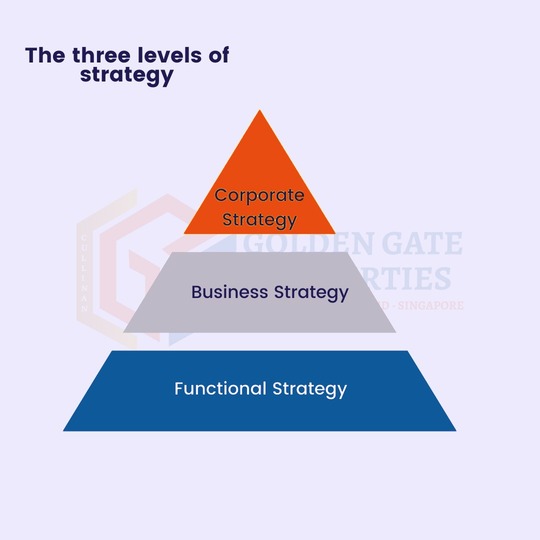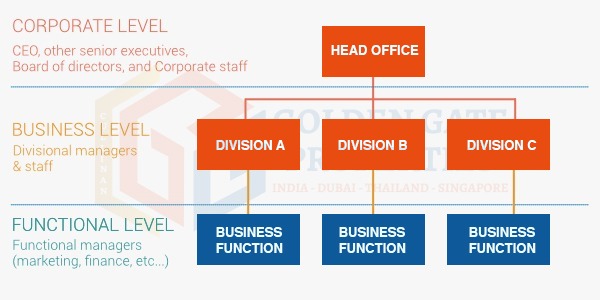
STRATEGY LEVELS.
What they are & HOW TO APPLY them
Every business leader should be familiar with the three levels of strategy. Like any business, strategy comes in various shapes and sizes. The strategy for a multi-national company will contrast with one from a startup.
Yet, the principles remain. To understand how strategies shift, we’ll look at the existing strategy levels and how an organization can apply them.
Ultimately, the biggest takeaway we hope you get from this post is that strategy is for everyone.
You don’t have to wait until your business grows to a certain size to “get strategic.” Instead, be conscious of where you are as a business so you can develop your strategy in a way that fits and grows with your organization.
We’ll discuss how the 3 strategy levels in an organization differ and provide some context on how to use these different levels of strategy in strategic management.
The 3 Levels Of Strategy Are:
The three levels of strategy are corporate-level strategy, business-level strategy, and functional-level strategy. We explain the differences and how to apply them in your organization. We also have separate articles on all 3 levels if you’re only interested in learning about a certain level. (Coming Soon)
No matter the level of strategy, “organizations that promote a transparency and collective culture when it comes to strategy, generate a stronger commitment and sense of accountability from their employees.” This statement by Guillermo Hermosillo Cue, Global Innovation Director at Burger King, echoes the importance of strategic communication regardless of the strategic level.

Corporate Level Strategy
Corporate strategies are the top level of strategy in an organization.
The corporate strategy defines the organization’s overall direction and the high-level ideas of how to move towards it. These plans are usually created by a select strategy group such as the CEO and the top management.
Generally, this is the group involved because they have a deep understanding of the company and the strategic business knowledge needed to steer the organization in the right direction.
A corporate strategy is generally broader than the other strategy levels. Strategies at this level are more conceptual and futuristic than business and functional level strategies. They usually span a 3-5 year period.
A corporate strategic plan generally encompasses:
- The vision for the organization
- The company’s values
- The strategic focus areas
- The strategic objectives
- The most important KPIs
Why create a Corporate Strategy?
In the corporate strategic plan, you’ll decide the markets you’ll compete in as an organization.
Then, it will direct the creation of business-unit-level and functional-level strategies.
These strategies, in turn, will guide the downstream decisions made by employees of all levels. Therefore, every decision made in the organization should directly or indirectly contribute to the strategy’s corporate objectives. If it’s not clear yet:
Every organization needs a corporate strategy.
There is no such thing as a too-small organization nor a too-large one to define what they want to achieve and how they will do it.
Recommended reading: WHY CONSTANT LEARNING TO C-SUIT?
Business Strategy Level
The business-level strategy is the second tier in the strategy hierarchy.
Sitting under the corporate strategy, the business strategy is a means to achieve the goals of a specific business unit in the organization.
One thing to note, implementing this strategy level is only useful for organizations with multiple business units. An organization with multiple business units may sell products and services or may sell multiple products/services in different industries.
A business-level strategy example
A large Bank is a prime example of an organization selling multiple services in different industries.
To name a few, it has business units in corporate banking, wealth management, risk management, and capital raising. Each of these business units would have distinct goals and a distinct business strategy to achieve these goals.
Why middle managers should create the business level strategy
Strategies at the business level should be constructed by the heads of business units and other middle managers within each unit.
It’s important to include a range of managers from each unit to participate in the strategy process because:
- It increases buy-in:
Managers who’ve had a chance to contribute to the strategy creation feel included in the decision-making. Therefore, they’re more likely to accept the strategy and jump on board with its execution. - It improves ownership:
Employees who are allowed to contribute to the formation of the strategy are more likely to take ownership of its completion.

Functional Level Strategy
This is the level at the operating end of an organization.
At the functional level of strategy, decisions made by employees are often described as tactical decisions. They are concerned with how the various functions of an organization contribute to the other strategy levels.
These functions can include marketing, finance, manufacturing, human resources, and more.
Functional strategy deals with a fairly restrictive plan. It gives the objectives for each specific function.
In simple terms, this is the strategy that will inform the day-to-day work of employees and will ultimately keep your organization moving in the right direction. The functional strategy level is probably the most important level of strategy.
This is because, without functional strategies, your organization can quickly lose traction and “get stuck” while competition moves forward.

Suppose you are a larger organization at this bottom strategy level. In that case, you start to think about how the various departments will contribute to your growth and how they will work together, keeping in mind your corporate strategy.
Recommended reading: Strategy Implementation & Management
Your marketing strategy, finance, IT, operations, and other departments all have goals and responsibilities to deliver. Having a visible functional level of strategy that aligns back to the overall corporate strategy will increase the chances of success.
Functional-level business strategy for a smaller organization
For a smaller organization, having a functional level is crucial.
If you’re one or two people, you may end up wearing more than one “functional hat.” Or, you may not have the various functions clearly defined – but they are still present.
So, you might not have a ‘marketing team’, but there are still marketing activities that need to be done. You may not have a ‘finance team’, but your organization still has bills that need to be paid and checks to be collected.
Developing a functional-level strategy will ensure that your organization’s steps are the right ones. As we mentioned earlier, the key takeaway here is that strategy is for everyone, no matter the stage of your business idea or organization.
The Three Levels Of Strategy Are The First Step
Of course, having a good (or great) strategy isn’t guaranteed success.
But it’s the place to start to succeed. Understanding the levels of strategy is a big part of getting the creation right. However, with increased levels, there can be increased confusion.
Our dedicated strategy team, GGP, will allow you to build your corporate plan, and then create plans at the business and functional levels with ease. GGP makes it super easy to align projects and collaborate across plans and departments.




[…] The 3 Levels of Strategy: The Difference & How to Apply Them […]